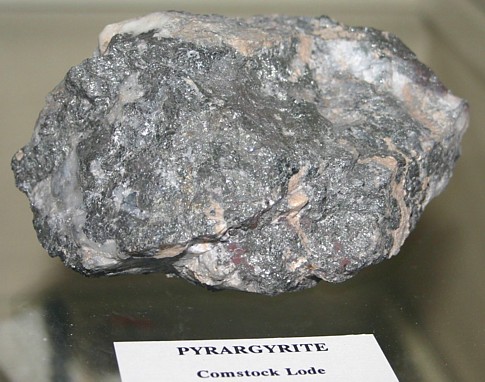|
.
Pyrargyrite Mineral Facts:
Chemical
Formula:
Ag3SbS3
Pyrargyrite is
59.7% Silver by weight. Also known as Dark Ruby Silver.
Colors:
Dark Gray to black.
The mineral is apparently opaque and its color is grayish black in
reflected light, but is transparent or translucent and deep ruby red in
transmitted light. Its streak is purplish red.
Hardness:
2 to 2.5
Density: 5.85
Cleavage:
The
cleavage of pyrargyrite is distinct parallel to R(1011). Its fracture is
conchoidal or uneven.
Crystallography: Orthorhombic
Crystals are usually distorted and often with complex development, and
frequently twinned.
Luster:.
Adamantine, transparent to translucent.
Optics:
(Refractive Index)
2.9 (very high index of
refraction)
|
 |
Composition,
Structure and Associated Minerals:
Pyrargyrite, or dark ruby silver,
is an important silver ore, especially in Mexico, Chile and the western
United States. It is a rare silver mineral and often associated with
proustite, acanthite, galena, calcite, etc. The name ruby silver is given to
it because thin splinters transmit a deep red light. The mineral is usually
mixed with other ores in compact masses, but it also forms handsome
crystals. Pyrargyrite occurs as a pseudomorph after native silver. On the
other hand it is occasionally altered to pyrite or argentite, and sometimes
to silver. The composition of pyrargyrite is represented by the formula Ag3SbS3
which demands 17.82 per cent S.; 22.21 per cent Sb.; 59.97 per cent Ag. Many
specimens of pyrargyrite contain also a small quantity of arsenic, through
the admixture of the isomorphous compound proustite. The analyses given
below show the effect of the intermixture of the two molecules.
It is not an
electrical conductor.
Identification and Diagnostics
On charcoal gives
dense white coating of antimony trioxide. After prolonged heating,
coating becomes tinged with a reddish color near assay due to a small
amount of volatilized silver. Odor of sulphur dioxide and coatings of
antimony oxides when heated in 0. T.
When
heated with sodium
carbonate on charcoal it is reduced to a globule of Silver which, when
dissolved in nitric acid, yields a silver chloride precipitate when
treated with a soluble chloride. The mineral dissolves in nitric acid
with the separation of sulphur and a white precipitate of antimony
oxide. It is also soluble in a strong solution of KOH. From this
solution HC1 precipitates orange Sb2S3
(compare with proustite). Characterized chiefly by its dark red color
and streak.
The color and streak of pyrargyrite,
together with its translucency, distinguish it from nearly all other
minerals. Its reaction for silver serves to distinguish it from cuprite,
cinnabar and realgar, which it sometimes resembles. The distinction between
this mineral and its isomorph, proustite, is based on the streak and the
reaction for antimony.
Occurrence,
Localities and Origins:
Pyrargyrite occurs
in veins associated with other compounds of
silver and sometimes with
galena
and arsenic. It is most common in the zone of secondary enrichment of silver
veins. The crystallized variety is found at Andreasberg in the Harz; at
Freiberg, in Saxony; at Pribram, in Bohemia; at many places in Hungary,
Transylvania;
Norway; in Guanajuato, Mexico;
and at Chanarcillo, in Chile.
The massive variety is worked as an ore of silver at Guanajuato in Mexico
and in several of the western states, as, for instance, in the Ruby
district, Gunnison Co.
Found in various silver
veins in the San Juan Mountains and elsewhere
in Colorado, at the Comstock
Lode and Austin, Nevada, and at several points in Idaho,
in the silver districts of
New Mexico, Utah and Arizona.
The mineral is an important ore of silver in Mexico and
in the western United States. It is usually associated with other sulfur
bearing ores of silver, the metal being extracted from the mixture by
various processes. The name is derived from two Greek words meaning
fire-silver.
Return to the
Mineral Collectors Information Page |
|


